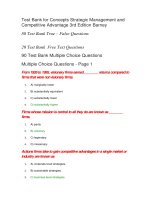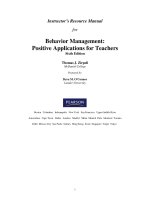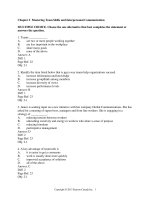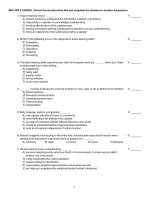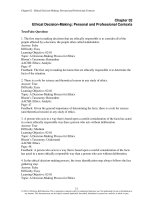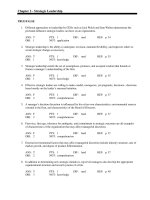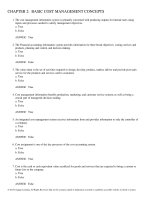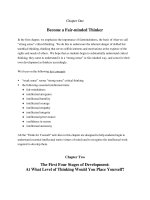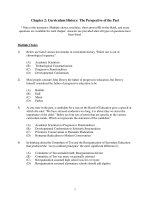Strategic management communication for leaders 3rd edition walker test bank
Bạn đang xem bản rút gọn của tài liệu. Xem và tải ngay bản đầy đủ của tài liệu tại đây (42.91 KB, 11 trang )
Name:
Class:
Date:
02 Foundations of Communication
1. The communication as information transfer model ignores the effects of distortion on information transfer or the
multiple possible interpretations that a receiver might make of a message.
a. True
b. False
ANSWER:
POINTS:
DIFFICULTY:
LEARNING OBJECTIVES:
NATIONAL STANDARDS:
STATE STANDARDS:
TOPICS:
KEYWORDS:
True
1
Difficulty: Easy
SMCL.WALK.11.LO: 2-1 - LO: 2-1
United States - BUSPROG: Analytic
United States - CA - DISC: Patterns
A-Head: Models of Communication
Bloom's: Comprehension
2. The primary weakness of the communication as transactional process model is the assumption of the possibility of
reaching shared meaning.
a. True
b. False
ANSWER:
POINTS:
DIFFICULTY:
LEARNING OBJECTIVES:
NATIONAL STANDARDS:
STATE STANDARDS:
TOPICS:
KEYWORDS:
True
1
Difficulty: Easy
SMCL.WALK.11.LO: 2-1 - LO: 2-1
United States - BUSPROG: Analytic
United States - CA - DISC: Patterns
A-Head: Models of Communication
Bloom's: Knowledge
3. The major criticism of the communication as strategic control approach is that it recognizes that people should not be
expected to communicate in any objectively rational way.
a. True
b. False
ANSWER:
POINTS:
DIFFICULTY:
LEARNING OBJECTIVES:
NATIONAL STANDARDS:
STATE STANDARDS:
TOPICS:
KEYWORDS:
Powered by Cognero
True
1
Difficulty: Easy
SMCL.WALK.11.LO: 2-1 - LO: 2-1
United States - BUSPROG: Analytic
United States - CA - DISC: Patterns
A-Head: Models of Communication
Bloom's: Knowledge
Page 1
Name:
Class:
Date:
02 Foundations of Communication
4. Communication as monologue is characterized by such attributes as trust, lack of pretense, humility, respect,
directness, open-mindedness, honesty, concern for others, non-manipulative intent, equality, and acceptance of others
as individuals with intrinsic worth, regardless of differences of opinion or belief.
a. True
b. False
ANSWER:
POINTS:
DIFFICULTY:
LEARNING OBJECTIVES:
NATIONAL STANDARDS:
STATE STANDARDS:
TOPICS:
KEYWORDS:
False
1
Difficulty: Easy
SMCL.WALK.11.LO: 2-1 - LO: 2-1
United States - BUSPROG: Analytic
United States - CA - DISC: Patterns
A-Head: Models of Communication
Bloom's: Knowledge
5. Dialogue means that there are always multiple interpretations of any situation and that no one person can control
those interpretations, try as he or she might.
a. True
b. False
ANSWER:
POINTS:
DIFFICULTY:
LEARNING OBJECTIVES:
NATIONAL STANDARDS:
STATE STANDARDS:
TOPICS:
KEYWORDS:
False
1
Difficulty: Moderate
SMCL.WALK.11.LO: 2-1 - LO: 2-1
United States - BUSPROG: Analytic
United States - Diversity
United States - CA - DISC: Stakeholders
A-Head: Models of Communication
Bloom's: Comprehension
6. Self-awareness is the idea that you behave and see yourself in ways that are consistent with how others see you.
a. True
b. False
ANSWER:
POINTS:
DIFFICULTY:
LEARNING OBJECTIVES:
NATIONAL STANDARDS:
STATE STANDARDS:
TOPICS:
KEYWORDS:
Powered by Cognero
False
1
Difficulty: Moderate
SMCL.WALK.11.LO: 2-3 - LO: 2-3
United States - BUSPROG: Reflective Thinking
United States - CA - DISC: Consequences
A-Head: Self-Awareness and Communication
Bloom's: Comprehension
Page 2
Name:
Class:
Date:
02 Foundations of Communication
7. Intrapersonal intelligence is the capacity to form an accurate model of oneself and to be able to use that model to
operate effectively in life.
a. True
b. False
ANSWER:
POINTS:
DIFFICULTY:
LEARNING OBJECTIVES:
NATIONAL STANDARDS:
STATE STANDARDS:
TOPICS:
KEYWORDS:
True
1
Difficulty: Easy
SMCL.WALK.11.LO: 2-3 - LO: 2-3
United States - BUSPROG: Reflective Thinking
United States - CA - DISC: Consequences
A-Head: Self-Awareness and Communication
Bloom's: Knowledge
8. Making inferential errors is a tendency to distort information that contradicts our currently held beliefs and attitudes.
a. True
b. False
ANSWER:
POINTS:
DIFFICULTY:
LEARNING OBJECTIVES:
NATIONAL STANDARDS:
STATE STANDARDS:
TOPICS:
KEYWORDS:
False
1
Difficulty: Moderate
SMCL.WALK.11.LO: 2-4 - LO: 2-4
United States - BUSPROG: Reflective Thinking
United States - CA - DISC: Conclusion
A-Head: Obstacles to Strategic and Ethical Communication
Bloom's: Knowledge
9. The more common way of processing information is absorbing it, which is a passive process that requires little
thinking
a. True
b. False
ANSWER:
POINTS:
DIFFICULTY:
LEARNING OBJECTIVES:
NATIONAL STANDARDS:
STATE STANDARDS:
TOPICS:
KEYWORDS:
Powered by Cognero
True
1
Difficulty: Easy
SMCL.WALK.11.LO: 2-4 - LO: 2-4
United States - BUSPROG: Analytic
United States - CA - DISC: Purpose
A-Head: Obstacles to Strategic and Ethical Communication
Bloom's: Knowledge
Page 3
Name:
Class:
Date:
02 Foundations of Communication
10. Critical thinkers actively seek alternative hypotheses, explanations, conclusions and sources and are open to them.
a. True
b. False
ANSWER:
POINTS:
DIFFICULTY:
LEARNING OBJECTIVES:
NATIONAL STANDARDS:
STATE STANDARDS:
TOPICS:
KEYWORDS:
True
1
Difficulty: Easy
SMCL.WALK.11.LO: 2-4 - LO: 2-4
United States - BUSPROG: Analytic
United States - CA - DISC: Analysis
A-Head: Obstacles to Strategic and Ethical Communication
Bloom's: Comprehension
11. The ____ model assumes that one person can transmit the information in his or her head without distortion or
personal interpretation to another.
a. Communication as information transfer
b. Communication as transactional process
c. Communication as strategic control
d. Communication as dialogic process
ANSWER:
POINTS:
DIFFICULTY:
LEARNING OBJECTIVES:
NATIONAL STANDARDS:
STATE STANDARDS:
TOPICS:
KEYWORDS:
Powered by Cognero
a
1
Difficulty: Moderate
SMCL.WALK.11.LO: 2-1 - LO: 2-1
United States - BUSPROG: Analytic
United States - CA - DISC: Stakeholders
A-Head: Models of Communication
Bloom's: Comprehension
Page 4
Name:
Class:
Date:
02 Foundations of Communication
12. The ____ model acknowledges that both senders and receivers are active and simultaneous interpreters of
messages as well as recognizes the importance of feedback, particularly of the nonverbal type, in meaning making.
a. Communication as information transfer
b. Communication as transactional process
c. Communication as strategic control
d. Communication as dialogic process
ANSWER:
POINTS:
DIFFICULTY:
LEARNING OBJECTIVES:
NATIONAL STANDARDS:
STATE STANDARDS:
TOPICS:
KEYWORDS:
b
1
Difficulty: Moderate
SMCL.WALK.11.LO: 2-1 - LO: 2-1
United States - BUSPROG: Analytic
United States - CA - DISC: Audience
A-Head: Models of Communication
Bloom's: Comprehension
13. The major criticism of the communication as strategic control model includes all of the following EXCEPT:
a. It recognizes that people should not be expected to communicate in any objectively rational way.
b. It lacks recognition that communication choices are socially, politically, and ethically motivated.
c. It assumes that communication is a tool that individuals use to control their environment.
d. It can lead to communicative practices that ignore the goals of clarity and honesty when it is in the
communicator's best individual interests to do so.
ANSWER:
POINTS:
DIFFICULTY:
LEARNING OBJECTIVES:
NATIONAL STANDARDS:
STATE STANDARDS:
TOPICS:
KEYWORDS:
Powered by Cognero
c
1
Difficulty: Moderate
SMCL.WALK.11.LO: 2-1 - LO: 2-1
United States - BUSPROG: Analytic
United States - CA - DISC: Audience
United States - CA - Stakeholders
A-Head: Models of Communication
Bloom's: Comprehension
Page 5
Name:
Class:
Date:
02 Foundations of Communication
14. Because of its focus on relationships and ethics, the best model of communication for the modern workplace is
a. communication as information transfer
b. communication as transactional process
c. communication as strategic control
d. communication as dialogic process
ANSWER:
POINTS:
DIFFICULTY:
LEARNING OBJECTIVES:
NATIONAL STANDARDS:
STATE STANDARDS:
TOPICS:
KEYWORDS:
d
1
Difficulty: Moderate
SMCL.WALK.11.LO: 2-1 - LO: 2-1
United States - BUSPROG: Analytic
United States - Diversity
United States - CA - DISC: Theory Application
A-Head: Models of Communication
Bloom's: Comprehension
15. The dialogic model of communication
a. Assumes that one person can transmit the information in his or her head without distortion or personal
interpretation to another.
b. Acknowledges that both senders and receivers are active and simultaneous interpreters of messages.
c. Assumes that communication is a tool used for controlling their environment.
d. Attempts to deal with the contested nature of communication as well as recognizes that we live in groups and
communities and that our actions affect others.
ANSWER:
POINTS:
DIFFICULTY:
LEARNING OBJECTIVES:
NATIONAL STANDARDS:
STATE STANDARDS:
TOPICS:
KEYWORDS:
Powered by Cognero
d
1
Difficulty: Easy
SMCL.WALK.11.LO: 2-1 - LO: 2-1
United States - BUSPROG: Analytic
United States - Diversity
United States - CA - DISC: Stakeholders
United States - CA - Receiver Reactions
A-Head: Models of Communication
Bloom's: Knowledge
Page 6
Name:
Class:
Date:
02 Foundations of Communication
16. Barnlund offers three types of communication to differentiate between monologic and dialogic communication,
including all of the following, EXCEPT:
a. Messages whose intent is to coerce others.
b. Messages of an exploitative sort in which words are arranged to filter the information, narrow the choices,
and obscure the consequences, so that only one meaning becomes attractive or appropriate.
c. Messages that are completely off the topic of conversation.
d. Facilitative communication in which words are used to inform, to enlarge perspective, to deepen sensitivity, to
remove external threat and to encourage independence of meaning.
ANSWER:
POINTS:
DIFFICULTY:
LEARNING OBJECTIVES:
NATIONAL STANDARDS:
STATE STANDARDS:
TOPICS:
KEYWORDS:
c
1
Difficulty: Challenging
SMCL.WALK.11.LO: 2-1 - LO: 2-1
United States - BUSPROG: Analytic
United States - CA - DISC: Stakeholders
A-Head: Models of Communication
Bloom's: Application
17. ____ means that there are always multiple interpretations of any situation and that no one person can control those
interpretations, try as he or she might.
a. Ethnocentrism
b. Plurality
c. Authentic dialog
d. Universality
ANSWER:
POINTS:
DIFFICULTY:
LEARNING OBJECTIVES:
NATIONAL STANDARDS:
STATE STANDARDS:
TOPICS:
KEYWORDS:
Powered by Cognero
b
1
Difficulty: Easy
SMCL.WALK.11.LO: 2-2 - LO: 2-2
United States - BUSPROG: Diversity
United States - CA - DISC: Consequences
A-Head: Models of Communication
Bloom's: Knowledge
Page 7
Name:
Class:
Date:
02 Foundations of Communication
18. ____ is an honest understanding of the self, including your attitudes, values, beliefs, strengths, and weaknesses.
a. Self-esteem
b. Confidence
c. Egocentrism
d. Self-awareness
ANSWER:
POINTS:
DIFFICULTY:
LEARNING OBJECTIVES:
NATIONAL STANDARDS:
STATE STANDARDS:
TOPICS:
KEYWORDS:
d
1
Difficulty: Moderate
SMCL.WALK.11.LO: 2-3 - LO: 2-3
United States - BUSPROG: Reflective Thinking
United States - CA - DISC: Consequences
A-Head: Self-Awareness and Communication
Bloom's: Knowledge
19. Challenges to our ability to make ethical and logical decisions when faced with a persuasive situation include all of
the following, EXCEPT:
a. Our self-awareness
b. Our thinking style
c. Our perceptual mindsets
d. Confirmation bias
ANSWER:
POINTS:
DIFFICULTY:
LEARNING OBJECTIVES:
NATIONAL STANDARDS:
STATE STANDARDS:
TOPICS:
KEYWORDS:
Powered by Cognero
a
1
Difficulty: Challenging
SMCL.WALK.11.LO: 2-4 - LO: 2-4
United States - BUSPROG: Reflective Thinking
United States - CA - DISC: Consequences
A-Head: Obstacles to Strategic and Ethical Communication
Bloom's: Comprehension
Page 8
Name:
Class:
Date:
02 Foundations of Communication
20. Sources of inferential errors include all of the following, EXCEPT:
a. A faulty information base or misinformation
b. A seriously limited information base
c. Vividness
d. Causation
ANSWER:
POINTS:
DIFFICULTY:
LEARNING OBJECTIVES:
NATIONAL STANDARDS:
STATE STANDARDS:
TOPICS:
KEYWORDS:
d
1
Difficulty: Moderate
SMCL.WALK.11.LO: 2-4 - LO: 2-4
United States - BUSPROG: Analytic
United States - CA - DISC: Conclusion
A-Head: Obstacles to Strategic and Ethical Communication
Bloom's: Comprehension
21. List the dimensions of emotional intelligence and briefly explain each one.
ANSWER:
1) Self-awareness is the ability to be aware of what you are feeling, 2) Selfmanagement is the ability to manage one's emotions and impulses, 3) Self-motivation is
the ability to persist in the face of setbacks and failures, 4) Empathy is the ability to
sense how others are feeling, and 5) Social skills is the ability to handle the emotions of
others.
POINTS:
1
DIFFICULTY:
Difficulty: Challenging
LEARNING OBJECTIVES: SMCL.WALK.11.LO: 2-3 - LO: 2-3
NATIONAL STANDARDS: United States - BUSPROG: Reflective Thinking
STATE STANDARDS:
United States - CA - DISC: Consequences
TOPICS:
A-Head: Self-Awareness and Communication
KEYWORDS:
Bloom's: Application
22. List three of the five types of inferential errors.
ANSWER:
The two general sources of inferential errors are a faulty information base or
misinformation, and a seriously limited information base. More specific sources of
inferential errors are vividness, unrepresentativeness, and correlation.
POINTS:
1
DIFFICULTY:
Difficulty: Moderate
LEARNING OBJECTIVES: SMCL.WALK.11.LO: 2-4 - LO: 2-4
NATIONAL STANDARDS: United States - BUSPROG: Analytic
STATE STANDARDS:
United States - CA - DISC: Conclusion
TOPICS:
A-Head: Obstacles to Strategic and Ethical Communication
KEYWORDS:
Bloom's: Knowledge
Powered by Cognero
Page 9
Name:
Class:
Date:
02 Foundations of Communication
23. List the three practices that can erroneously support our perceptual mindsets.
ANSWER:
Our perceptual mindsets are affected by several practices that limit our ability to
consider information thoroughly and objectively. These include confirmation bias, false
dichotomies, and inferential errors.
POINTS:
1
DIFFICULTY:
Difficulty: Moderate
LEARNING OBJECTIVES: SMCL.WALK.11.LO: 2-4 - LO: 2-4
NATIONAL STANDARDS: United States - BUSPROG: Reflective Thinking
STATE STANDARDS:
United States - CA - DISC: Consequences
TOPICS:
A-Head: Obstacles to Strategic and Ethical Communication
KEYWORDS:
Bloom's: Comprehension
24. List the four models of communication and indicate which is best for today's workplace and briefly explain why.
ANSWER:
1) Communication as information transfer, 2) Communication as transactional process,
3) Communication as strategic control, and 4) Communication as dialogic process.
Communication as dialogic process is best because of its focus on relationship and its
inherent consideration of communication ethics. Students might also elaborate on the
alignment between the characteristics of the dialogic model and the changing
workplace environment, including flattening heirarchies, mergers, and increasing
diversity. In addition, they may discuss how the dialogic model allows individuals across
the organization to be leaders regardless of their position within the organization.
POINTS:
1
DIFFICULTY:
Difficulty: Challenging
LEARNING OBJECTIVES: SMCL.WALK.11.LO: 2-1 - LO: 2-1
NATIONAL STANDARDS: United States - BUSPROG: Analytic
STATE STANDARDS:
United States - CA - DISC: Stakeholders
TOPICS:
A-Head: Models of Communication
KEYWORDS:
Bloom's: Analysis
Powered by Cognero
Page 10
Name:
Class:
Date:
02 Foundations of Communication
25. What are the challenges to implementing a dialogic model of communication in today's workplace?
ANSWER:
1) An overly rigid view of one's identity or self-perception may lead to unwillingness to
engage in dialog with others who have differing perspectives, 2) assumptions of the
superiority of our own culture or ethnocentrism, and 3) assumptions about the
universality of our own cultural beliefs.
Students might also discuss difficulties including inaccurate perceptions of the purpose
of communication based on the transactional model, strategic control model, etc.
POINTS:
1
DIFFICULTY:
Difficulty: Challenging
LEARNING OBJECTIVES: SMCL.WALK.11.2-2 - 2-2
SMCL.WALK.11.LO: 2-4 - LO: 2-4
NATIONAL STANDARDS: United States - BUSPROG: Analytic
United States - Diversity
STATE STANDARDS:
United States - CA - Conclusions
United States - CA - DISC: Stakeholders
TOPICS:
A-Head: Obstacles to Strategic and Ethical Communication
KEYWORDS:
Bloom's: Evaluation
Powered by Cognero
Page 11
